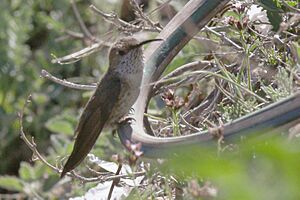White-sided hillstar facts for kids
The white-sided hillstar (Oreotrochilus leucopleurus) is a beautiful species of hummingbird. It belongs to a group called "coquettes." You can find this tiny bird in Argentina, Bolivia, and Chile in South America.
Quick facts for kids White-sided hillstar |
|
|---|---|
 |
|
 |
|
| Male above (Chile), female below (Argentina) |
|
| Conservation status | |
| Scientific classification | |
| Genus: |
Oreotrochilus
|
| Species: |
leucopleurus
|
 |
|
| Distribution in South America (green) | |
Contents
What Kind of Bird Is It?
The white-sided hillstar is a type of hummingbird. Scientists once thought it might be a subspecies of the Andean hillstar. However, most experts now agree it is its own unique species. It is a "monotypic" species, which means it does not have any subspecies.
How to Spot a White-Sided Hillstar
This hummingbird is about 13 to 15 cm (5.1 to 5.9 in) long. That's about the length of your hand! It weighs around 7.9 to 8.4 g (0.28 to 0.30 oz), which is less than a few paper clips.
Adult birds have a black beak that curves slightly downwards. The male white-sided hillstar has dull brown feathers on its back. Its throat has a shiny green patch called a gorget. This green patch has a black edge. Below the black edge, its chest and belly are white. A wide blue-black stripe runs down the middle of its belly. Its tail is a bronzy black color. The outer tail feathers have white at their base.
The female white-sided hillstar also has dull brown feathers on her back. Her underside is mostly dull brown too. Her throat is pale with small dark speckles. Her tail is greenish-black. The outer three or four pairs of her tail feathers have a lot of white at their bases and tips. Young birds look more grayish than adult birds. Young males have a dark blue-green gorget.
Where Do White-Sided Hillstars Live?
You can find the white-sided hillstar in the Andes mountains. They live from central Bolivia, specifically the Cochabamba Department, all the way south through Chile to the Biobío Region. They also live in Argentina, as far south as Santa Cruz Province.
These birds like to live in puna grasslands. These grasslands have small shrubs, cacti, and Puya plants. They usually live at elevations from 1,200 to 4,000 m (3,900 to 13,100 ft) high. Sometimes, they even go higher, close to the snow line!
How White-Sided Hillstars Behave
Moving Around
White-sided hillstars usually leave Chile during the winter months. This is called the Austral winter. However, some birds just move to lower places where it's warmer. Some might even move further north into Bolivia during late winter or early spring.
What Do They Eat?
We don't know a lot about what white-sided hillstars eat. But, scientists think their diet is similar to their close relatives, the Andean hillstars. Andean hillstars drink nectar from many different flowering shrubs, cacti, and trees. They usually perch on a branch to drink nectar, instead of hovering. They also pick up small bugs, called arthropods, from plants. Sometimes, they even catch bugs while flying!
Reproduction and Life Cycle
White-sided hillstars lay their eggs in November and December. They build a large cup-shaped nest. They use a sticky substance to glue their nest to a vertical rock face. They choose a spot that is well-protected from danger. A female usually lays two eggs. We don't know much else about how these birds raise their young.
What Sounds Do They Make?
We don't know a lot about the sounds white-sided hillstars make. They do make a short, repeated "tsit" call. They also make a fast, twittering sound when they are chasing each other or showing off.
How Are They Doing?
The IUCN (International Union for Conservation of Nature) has looked at the white-sided hillstar. They have decided it is a species of "Least Concern." This means they are not currently worried about it becoming endangered. We don't know exactly how many white-sided hillstars there are. However, scientists believe their numbers are stable. They are generally common and live in several protected areas. Their main habitat is not under much threat from people.


